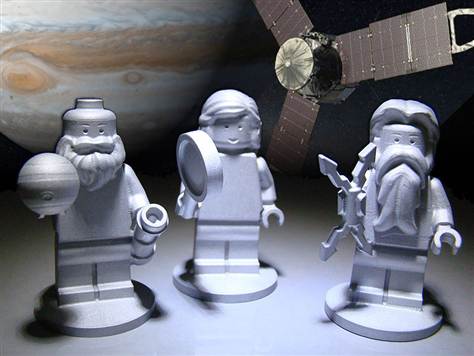It’s Friday and this story made me smile. Having just concluded a 30-year run of the Space Shuttle program, NASA continues its space explorations in a new era—one without low-orbit vehicles. NASA’s new space program is still on hold while the government decides its fate through a series of funding decisions. However, this hasn’t stopped NASA from launching rockets.
This particular rocket launched today from Cape Canaveral, Florida and set into a trajectory aimed at Jupiter. NASA believes that learning more about the largest planet will enable us to learn more about how our solar system and Earth were created. The rocket, so aptly named Juno is an Atlas V rocket and is being managed by the Jet Propulsion Laboratory at a price tag of $1.1 billion.
The part that made me smile was that onboard this “un-manned” rocket are three Lego characters made from special space grade aluminum! These three characters were custom designed for this rocket and are in the shapes of Jupiter himself, his wife Juno and (presumably close family friend), Galileo Galilei. That’s right, NASA has sent the God and his company back home. The trip is a mere 1.7 billion miles away and expected to arrive around July of 2016. Let’s just hope there are no crying babies onboard.

Once in Jupiter’s orbit, the rocket is scheduled to make 33 revolutions in just about 1 year and will begin returning data sometime in 2017. Along with the flight crew and passengers, a plaque has been placed on board to honor Galileo’s discovery of Jupiter that reads:
On the 11th it was in this formation — and the star closest to Jupiter was half the size than the other and very close to the other so that during the previous nights all of the three observed stars looked of the same dimension and among them equally afar; so that it is evident that around Jupiter there are three moving stars invisible till this time to everyone.
Sending Legos into outer space actually has a legitimate purpose! It’s part of the Bricks in Space project, the joint outreach and educational program developed as part of the collaboration between NASA and the Lego Group to inspire children to explore science, technology, engineering and mathematics.